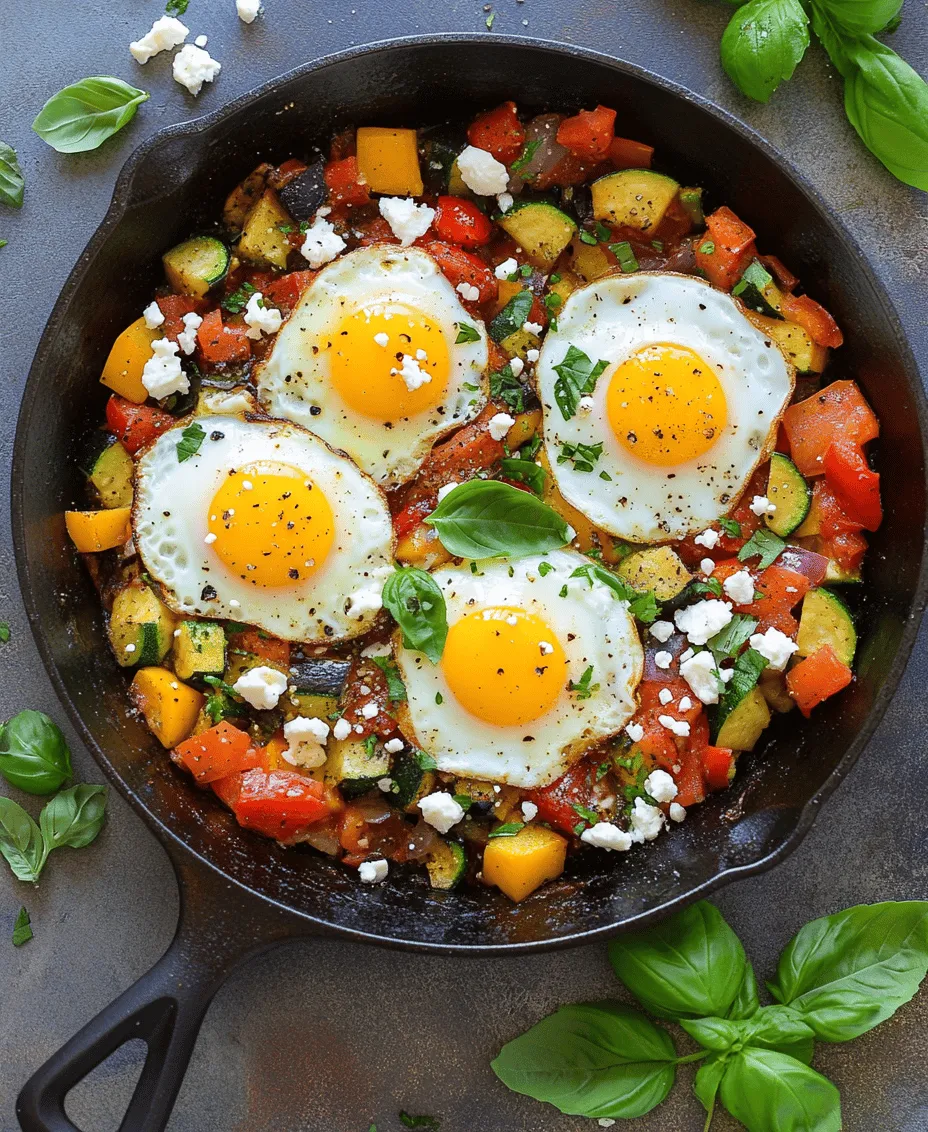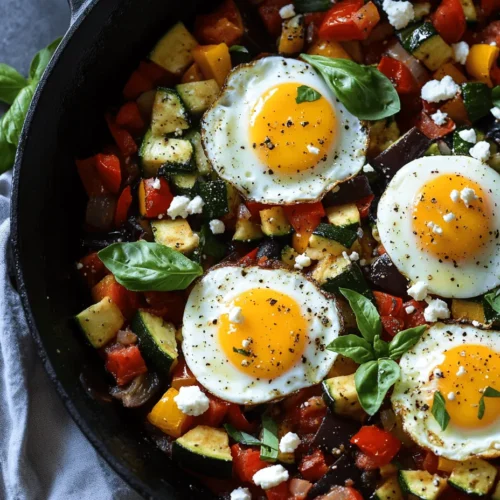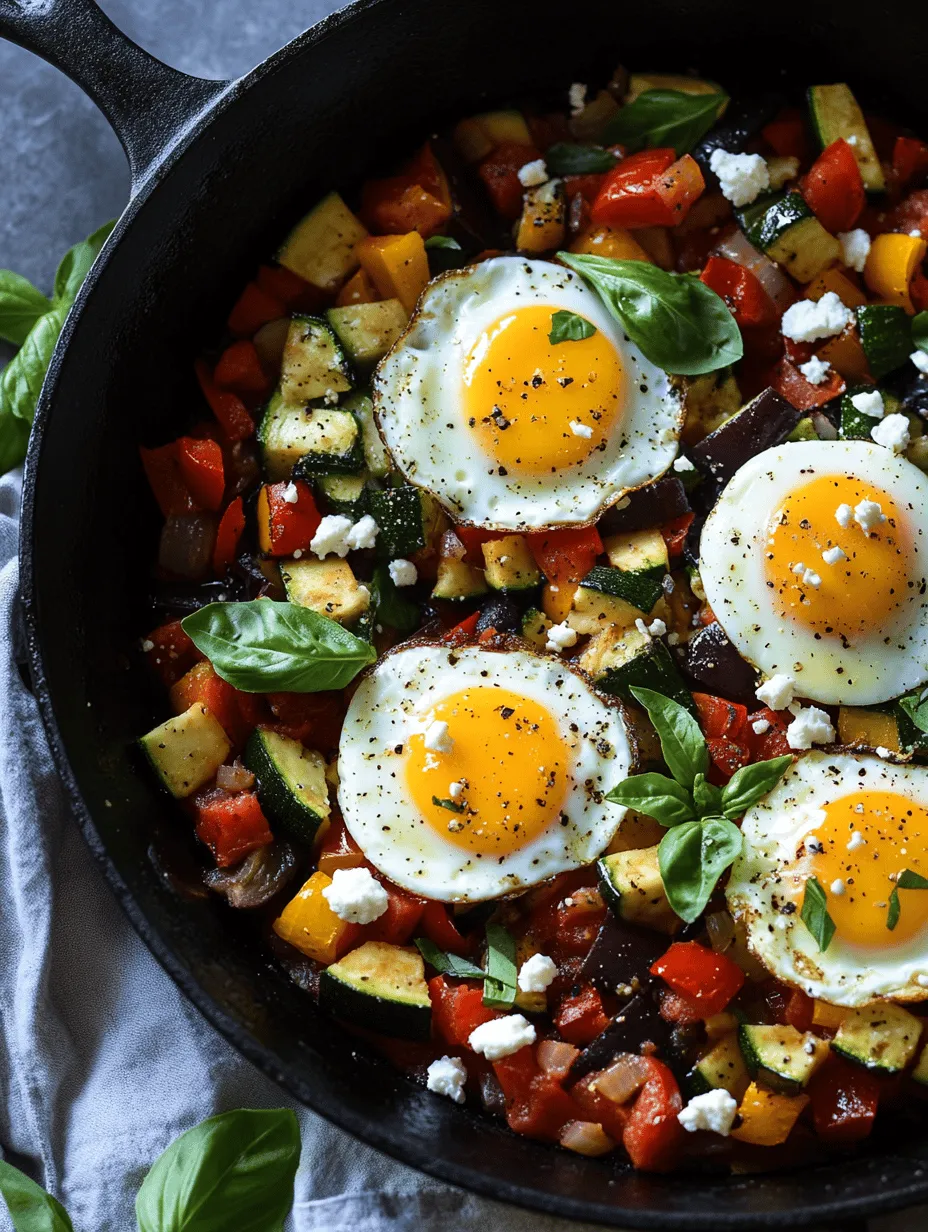Introduction
As the sun shines bright and the days grow longer, summer beckons us to celebrate the bounty of vibrant, fresh vegetables. One dish that perfectly encapsulates the essence of summer is Ratatouille—a classic French dish that showcases the flavors of seasonal produce. Originating from the Provence region of France, ratatouille is traditionally a medley of vegetables such as eggplant, zucchini, peppers, and tomatoes, all simmered together to create a hearty and flavorful dish.
What sets our Summer Skillet Ratatouille apart is the delightful addition of eggs. This unique twist not only enhances the dish’s nutritional value by adding protein and richness but also transforms it into a complete meal that can be enjoyed any time of the day. Whether served as a light lunch, a comforting dinner, or even a brunch centerpiece, this dish is sure to impress.
In this article, we’ll delve into the history of ratatouille, explore its seasonal ingredients, and guide you through the preparation steps that will bring this colorful and nutritious dish to life.
Understanding Ratatouille
Historical Background of Ratatouille in French Cuisine
Ratatouille has roots that date back to the early 18th century in the Provence region of southern France. The name “ratatouille” is derived from the French word “ratatouiller,” which means “to stir up.” Originally considered a peasant dish, ratatouille was a way for farmers to use up their surplus vegetables during the summer harvest. Over time, it evolved into a beloved culinary staple, celebrated for its simplicity and versatility.
The traditional preparation involves cutting vegetables into uniform pieces and simmering them until they meld into a flavorful stew. However, there are many variations of ratatouille, with each region and family adding their own spin. Today, ratatouille is widely recognized around the world, thanks in part to its appearance in popular culture, such as the Disney movie “Ratatouille.”
The Significance of Seasonal Vegetables in Traditional Recipes
At the heart of ratatouille is its celebration of seasonal vegetables. The dish typically includes eggplant, zucchini, bell peppers, tomatoes, and onions—all of which shine during the summer months. Using fresh, seasonal produce not only enhances the flavor of the dish but also ensures that it is packed with nutrients.
In traditional French cooking, the emphasis on using seasonal ingredients is not just about taste; it reflects a deep respect for the land and the cycles of nature. Each vegetable brings its unique flavor and texture to the dish, creating a harmonious blend that is both satisfying and nourishing.
Overview of How This Dish Embodies the Essence of Summer
Summer is a time of abundance, and ratatouille embodies this spirit by showcasing the best that the season has to offer. The vibrant colors of the vegetables—deep purple eggplant, bright yellow zucchini, and rich red tomatoes—create a visual feast that is as appealing to the eye as it is to the palate.
Moreover, ratatouille is a dish that encourages creativity and improvisation. Home cooks can adapt the recipe based on what they have on hand or what is available at their local farmers’ market. This flexibility makes it a perfect choice for summer meals when the garden is overflowing with fresh produce.
Ingredients Breakdown
To create a delicious Summer Skillet Ratatouille with Eggs, it is essential to choose high-quality ingredients, as they will directly impact the overall flavor and nutritional profile of the dish. Below, we breakdown the key ingredients and their roles in this delightful recipe.
Detailed Description of Each Ingredient and Its Role in the Dish
– Eggplant: This star ingredient adds a creamy texture and absorbs the flavors of the other vegetables. It is rich in fiber and antioxidants, making it a healthy choice for any meal.
– Zucchini: With its mild flavor and tender texture, zucchini complements the other vegetables perfectly. It is low in calories and high in vitamins A and C, making it a nutritious addition.
– Bell Peppers: Available in various colors, bell peppers contribute sweetness and crunch to the dish. They are an excellent source of vitamins A and C and contain antioxidants that support overall health.
– Tomatoes: Fresh tomatoes bring acidity and juiciness to the ratatouille, balancing the flavors of the other ingredients. They are rich in lycopene, an antioxidant linked to numerous health benefits.
– Onions: Onions form the aromatic base of the dish, providing depth of flavor. They are high in antioxidants and can contribute to heart health.
– Garlic: Known for its robust flavor and health benefits, garlic adds a savory note to the ratatouille. It is renowned for its anti-inflammatory properties.
– Olive Oil: A staple in Mediterranean cooking, high-quality extra virgin olive oil enhances the dish’s flavors while providing healthy fats. Its rich flavor profile complements the other ingredients beautifully.
– Eggs: The addition of eggs not only elevates the dish by adding protein and richness but also creates a lovely contrast in texture. When cooked just right, the yolks become creamy and add a luxurious touch.
Nutritional Benefits of the Main Ingredients
The combination of vegetables in ratatouille offers a wealth of nutritional benefits. This dish is low in calories yet rich in vitamins, minerals, and fiber, making it an excellent choice for health-conscious eaters. The inclusion of eggs further boosts the protein content, making it a satisfying meal that can help keep you full for longer.
Importance of Using Fresh, Seasonal Produce
Using fresh, seasonal produce is crucial for achieving the best flavor in your Summer Skillet Ratatouille. The vibrant colors and flavors of freshly picked vegetables make all the difference, enhancing the overall taste and appeal of the dish. When vegetables are in season, they are often more affordable and accessible, allowing you to create a delicious meal without breaking the bank.
Preparation Steps
Now that we’ve covered the ingredients and their significance, let’s dive into the preparation steps for creating your Summer Skillet Ratatouille with Eggs. This process is straightforward and allows you to enjoy the cooking experience while producing a beautiful and nourishing dish.
Preparing the Vegetables
The first step in making ratatouille is to prepare your vegetables. Begin by washing them thoroughly under cold water to remove any dirt or pesticides. Once cleaned, you’ll want to chop them into uniform pieces. This is important for even cooking and ensures that each ingredient contributes its flavor to the dish.
– Eggplant: Cut the eggplant into cubes, about 1-inch in size. If you prefer, you can salt the eggplant beforehand to draw out excess moisture and reduce bitterness. Simply sprinkle salt over the cubed eggplant, let it sit for about 30 minutes, then rinse and pat dry.
– Zucchini: Slice the zucchini into half-moons or rounds, about 1/2-inch thick. This size allows the zucchini to cook quickly while still maintaining some bite.
– Bell Peppers: Remove the stems and seeds from the bell peppers, then chop them into bite-sized pieces. Feel free to use a mix of colors for visual appeal.
– Tomatoes: If using fresh tomatoes, chop them into chunks. You can also use canned diced tomatoes for convenience, as they provide a similar flavor profile.
– Onions and Garlic: Dice the onions and mince the garlic. The aromatics will form the base of your ratatouille, so be sure to chop them finely for even cooking.
Importance of Uniform Chopping for Even Cooking
Uniform chopping is key to achieving a well-cooked ratatouille. When vegetables are cut into similar sizes, they will cook at the same rate, preventing some from becoming mushy while others remain undercooked. This attention to detail will enhance the overall texture and flavor of the dish.
Tips on Selecting and Storing Fresh Vegetables
When selecting vegetables for your ratatouille, look for produce that is firm, vibrant, and free from blemishes. The best place to find fresh, seasonal vegetables is at your local farmers’ market, where you can also ask the vendors about their growing practices.
To store your vegetables, keep them in a cool, dry place or in the refrigerator, depending on the type. For example, eggplants and zucchini should be stored in the fridge, while tomatoes are best kept at room temperature to preserve their flavor.
Heating the Olive Oil
Once your vegetables are prepped, it’s time to start cooking! Begin by heating a generous amount of extra virgin olive oil in a large skillet over medium heat. The choice of cooking oil is crucial, as it imparts flavor and helps in the sautéing process. Olive oil is an excellent choice due to its rich taste and health benefits, making it a staple in Mediterranean cuisine.
Discussion on the Choice of Cooking Oil and Its Flavor Profile
Choosing the right cooking oil can significantly affect the flavor profile of your dish. While olive oil is the traditional choice for ratatouille, you can also experiment with other oils, such as avocado oil or grapeseed oil, if you prefer a different taste. However, olive oil’s fruity notes and its ability to withstand medium heat make it an ideal option for sautéing vegetables.
Sautéing Onions and Garlic
Once the olive oil is heated, add the diced onions to the skillet. Sauté them for about 3-5 minutes, or until they become translucent and fragrant. Next, add the minced garlic and cook for an additional minute, being careful not to let it burn, as burnt garlic can impart a bitter taste.
The combination of onions and garlic will form a flavorful base for your ratatouille, infusing the dish with aromatic goodness. The sautéing process is essential for developing depth of flavor and will set the stage for the rest of the vegetables.
Cooking the Eggplant
After sautéing the onions and garlic, it’s time to add the eggplant to the skillet. Cook it for about 5-7 minutes, stirring occasionally, until it begins to soften and turn golden brown. Cooking the eggplant properly is crucial, as undercooked eggplant can be tough and unpalatable.
As the eggplant cooks, it will absorb the flavors of the onions and garlic, creating a rich foundation for the dish. If you salted the eggplant earlier, you may find that it releases some moisture during cooking, which will help to create a flavorful base.
Importance of Cooking Eggplant Properly to Achieve Desired Texture
Cooking eggplant properly is key to achieving the desired texture in your ratatouille. When cooked correctly, eggplant should be tender and creamy, contributing to the overall mouthfeel of the dish. Make sure to stir occasionally to prevent it from sticking to the skillet and to ensure even cooking.
Building the Flavor
Once the eggplant has cooked down, it’s time to add the remaining vegetables—zucchini, bell peppers, and tomatoes. Stir them into the skillet and allow them to cook together for about 10-15 minutes, or until they are tender and the flavors meld beautifully. Season the mixture with salt, pepper, and any additional herbs you prefer, such as thyme or basil, to enhance the dish further.
As the vegetables cook, their natural juices will release, creating a luscious sauce that binds everything together. The vibrant colors and aromas will fill your kitchen, making it impossible to resist the anticipation of enjoying this delicious summer dish.
In the next section, we will continue with the remaining preparation steps, including the addition of eggs and cooking techniques to ensure the perfect Summer Skillet Ratatouille. Stay tuned for tips on achieving the ideal egg consistency, serving suggestions, and much more!

Incorporating the remaining vegetables into your Summer Skillet Ratatouille is the key to achieving a vibrant and flavorful dish that embodies the essence of summertime. Start by adding your bell peppers, zucchini, and eggplant, which are essential to this classic French dish. Each of these vegetables brings unique flavors and textures that contribute to the overall experience.
Layering of Flavors with Each Vegetable Addition
As you add each vegetable, consider the order in which they are incorporated. Begin with the denser vegetables, such as the eggplant and bell peppers, which take longer to cook. Sauté them until they soften and give off their natural juices. The zucchini, being more delicate, should be added later. This layering technique not only enhances the dish’s flavor profile but also ensures that each vegetable retains its distinct texture.
The eggplant absorbs flavors beautifully and adds a rich, meaty quality to the ratatouille. The bell peppers bring a sweetness that balances the dish, while the zucchini provides a light and refreshing crunch. As you cook, be sure to stir gently to avoid breaking down the vegetables too much; you want them to hold their shape and contribute to the rustic charm of the dish.
Role of Herbs and Spices
Herbs and spices play a pivotal role in elevating the Ratatouille, enhancing its aromatic qualities and depth of flavor. As you sauté the vegetables, incorporate dried oregano, fresh basil, and a pinch of red pepper flakes. Oregano adds an earthy, slightly bitter note that complements the sweetness of the peppers and tomatoes. Fresh basil, added towards the end of cooking, provides a fragrant lift that brightens the entire dish. Finally, the red pepper flakes introduce a subtle heat that balances the sweetness of the vegetables, making each bite exciting.
Simmering the Ratatouille
Once all the vegetables are added and seasoned, it’s time to let the ratatouille simmer. This step is essential for allowing the flavors to meld together. Cover the skillet with a lid and reduce the heat to low. Simmer for about 15-20 minutes, stirring occasionally. The goal here is to cook the vegetables until they are tender, but not mushy. You’ll know they’re perfectly cooked when they are fork-tender but still retain some bite.
Simmering not only concentrates the flavors but also helps to develop a rich, savory sauce from the natural juices of the vegetables. The aroma that fills your kitchen during this time is a delightful indication that your dish is coming together beautifully.
Cooking the Eggs
After your ratatouille has simmered to perfection, it’s time to add the eggs. Creating wells in the ratatouille is a crucial step in this process. Use a large spoon to make small indentations in the mixture where the eggs will go. This not only helps the eggs to cook evenly but also creates a stunning visual presentation when serving.
Importance of Wells for Egg Placement
The wells you create will cradle the eggs, ensuring they cook properly while allowing the yolks to stay intact. This method adds a rustic charm to your ratatouille, showcasing the beautiful golden yolks against the colorful medley of vegetables. The visual appeal of the dish is often just as important as the taste, and this technique enhances both.
Cooking Techniques for Eggs
When it comes to cooking the eggs, you have options depending on your preference for doneness. For runny yolks, cover the skillet and cook the eggs on low heat for about 4-5 minutes. Keep an eye on them to avoid overcooking; the goal is to have the whites set while the yolks remain gooey and rich. If you prefer fully cooked eggs, extend the cooking time to 8-10 minutes until the yolks are firm.
Tips for Achieving the Perfect Egg Texture
To achieve the perfect egg texture, consider these tips:
1. Fresh Eggs: Use the freshest eggs you can find; they will hold their shape better.
2. Temperature Control: Start cooking on low heat to gently set the whites without overcooking the yolks.
3. Cover the Skillet: Using a lid traps heat and steam, helping to cook the eggs evenly.
Serving Suggestions
Once the eggs are cooked to your liking, it’s time to serve your Summer Skillet Ratatouille. For a rustic presentation, serve directly from the skillet, allowing your guests to help themselves. This not only adds to the casual summer vibe but also keeps the dish warm throughout the meal.
Garnish the ratatouille with fresh basil, which adds a pop of color and a burst of flavor. Crumbled feta cheese is an excellent addition, providing a creamy, tangy contrast to the sweetness of the vegetables and richness of the eggs.
Pairing Ideas
Pair your ratatouille with crusty bread for a delightful dipping experience, or serve it alongside a light salad for a refreshing side. A crisp white wine, such as a Sauvignon Blanc or a rosé, complements the dish beautifully, enhancing the summer feel of your meal.
Nutritional Information
This Summer Skillet Ratatouille is not only delicious but also packed with health benefits. The dish is rich in vitamins, minerals, and antioxidants, thanks to the colorful array of vegetables. Each serving contains approximately 250 calories, making it a wholesome option for lunch or dinner.
Macronutrient Breakdown:
– Protein: 12g
– Carbohydrates: 22g
– Fat: 15g
It’s suitable for various dietary preferences, including vegetarian and gluten-free diets, making it a versatile choice for gatherings.
Conclusion
In conclusion, the Summer Skillet Ratatouille with Eggs is a delightful dish that captures the essence of summer. With its vibrant colors, robust flavors, and wholesome ingredients, it serves as a perfect centerpiece for family meals or casual gatherings with friends. As you experiment with seasonal vegetables, feel free to customize the recipe to your liking, incorporating whatever fresh produce is available.
Cooking is not just about nourishment; it’s about joy, creativity, and the pleasure of sharing meals with loved ones. So gather your friends and family around the table, serve your beautiful ratatouille straight from the skillet, and savor the flavors of summer together.



